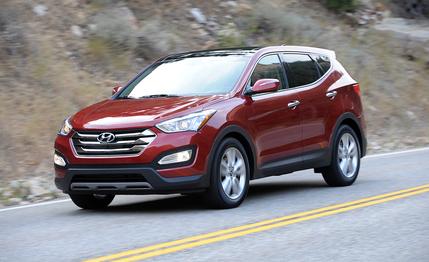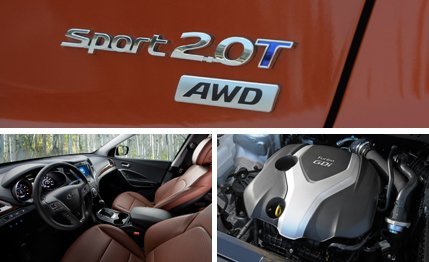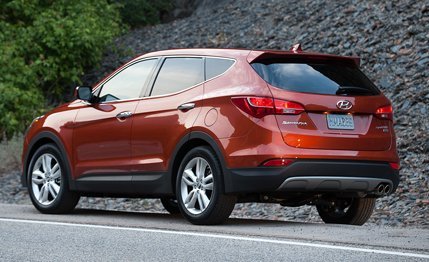
 Instrumented Test
Instrumented Test




The five-passenger Hyundai Sonata wagon—er, Santa Fe—is Hyundai’s ticket to the bountiful buffet of the crossover market that represents much of America’s current car spending. And like its many, many competitors, the Sonata-based Santa Fe can be moved upscale PDQ from its $25,275 base price.
Just by checking one box for the Technology package ($2700) that includes an eight-inch navigation screen, a sunroof, and a heated steering wheel, you are also loaded down with an additional $3900 in required options. Go ahead, splurge! You can identify the cheapskates because they don’t have an electroluminescent gauge cluster, heated rear seats, or premium doorsill plates on their Santa Fes.
Even with regular doorsill plates, the new Santa Fe draws the eye. Shaped like a robot’s ski boot, it is stocky, glaring, and masculine, traits that crossovers aren’t always known for. Obviously, Hyundai would like some men to get in the queue as well for its cute ute.


Americans long ago junked their Country Squires for SUVs, but they never lost their taste for luxury gloss. The Santa Fe goes after them with a fussed-over cabin that looks expensive. Seemingly all of the metals on the periodic table are represented by various bits of plastic trim as the dash arcs grandly over the legs of the driver and front-seat passenger. At the center, columns sprout down from the panel to create an architectural void into which people can toss their clutter.
It’s not a dashboard, it’s a Lucasfilm production. Heck, every window switch looks like it has four part numbers. But the Santa Fe interior mostly works ergonomically. Where it fails taller people is in the inadequate reach of the telescoping steering column. Sitting too close means knees bang the dash. And the navigation’s obligatory legal disclaimer won’t go away if you ignore it, as it does now, blessedly, on many cars.
A longer, three-row, V-6–powered Santa Fe GLS is coming, but even the short-wheelbase Santa Fe Sport is large for its segment, with lots of legroom in back and up to 72 cubic feet of cargo space behind the front seats. Convenient handles in the cargo area release the seatbacks of the second row, which fold almost-but-not-quite flat, assuming you have either removed the headrests or slid the front seats forward a little. A wide chasm between the rear-wheel humps means that we were able to slide in an antique china cabinet with room to spare.


The cabin remains quiet, so you can use your inside voice during Bluetooth calls. The base engine—the 190-hp 2.4-liter direct-injected four-cylinder (a 264-hp turbo 2.0-liter is also offered)—does its work with an anodyne efficiency. Aided by the six-speed automatic, it keeps the 3726 pounds moving just at the speed of sanity. With a 0-to-60-mph time of 8.6 seconds, the nonturbo Santa Fe doesn’t do emergencies, however. If you press for speed, you’ll see mileage drop; we averaged 22 mpg, 1 mpg above the city EPA rating.
After weathering criticism for its slovenly dynamics, Hyundai touts the Santa Fe as a step forward. We weren’t overly impressed, nor were we disappointed. The chassis and steering supply a solid feeling of control while largely absorbing the highway’s imperfections, and that’s about all we ask of a crossover. Even Mazda’s CX-5 isn’t hugely more fun to steer.
So the Santa Fe scores par in dynamics and a birdie in refinement and utility. Just be prepared to dish it out for the extras.